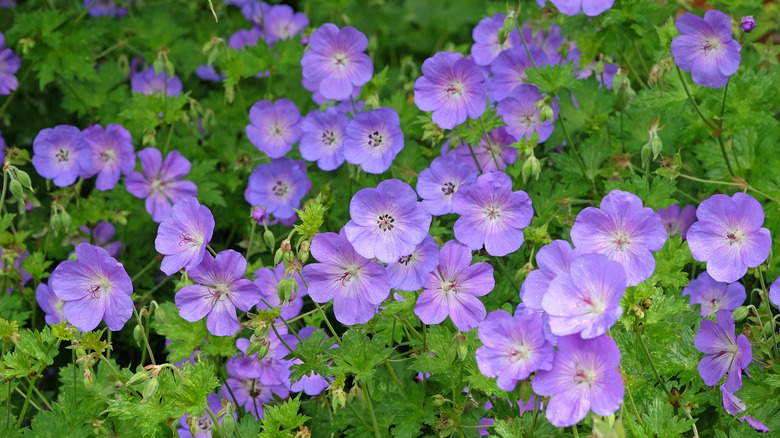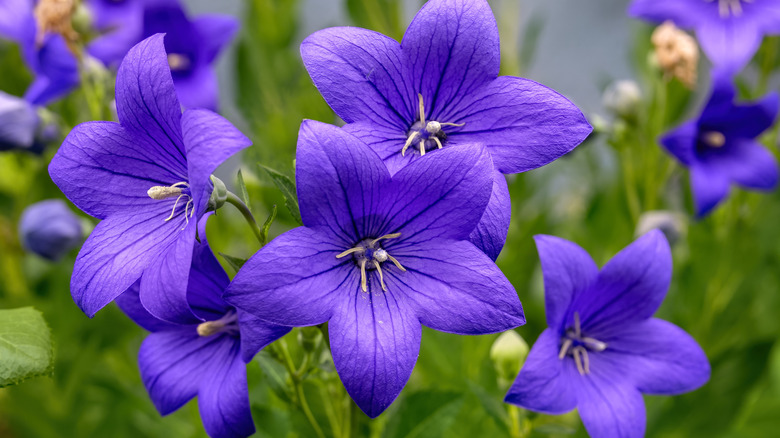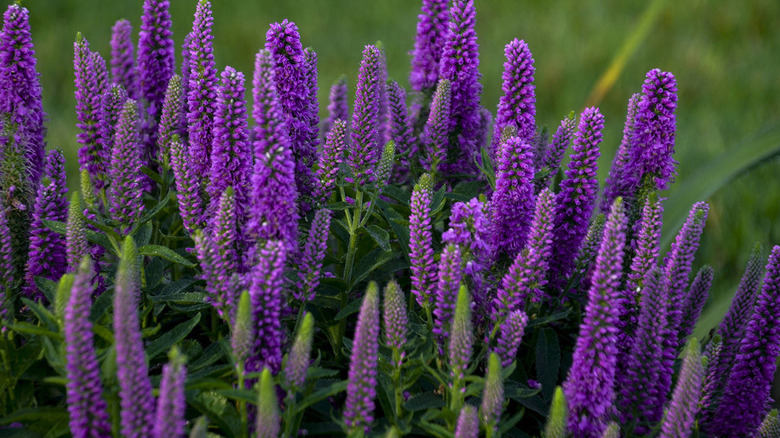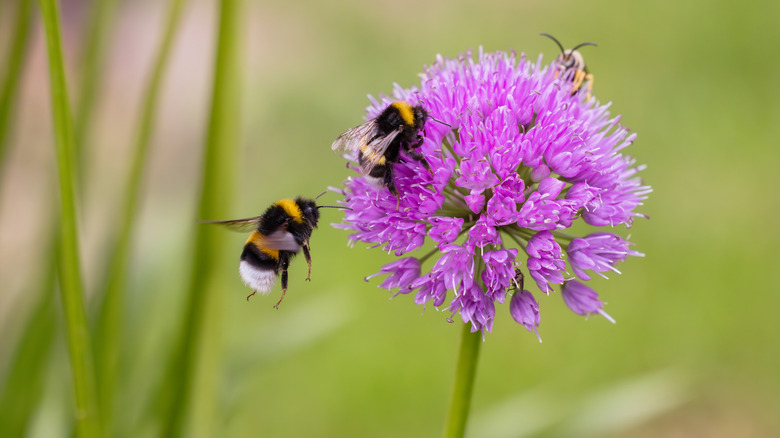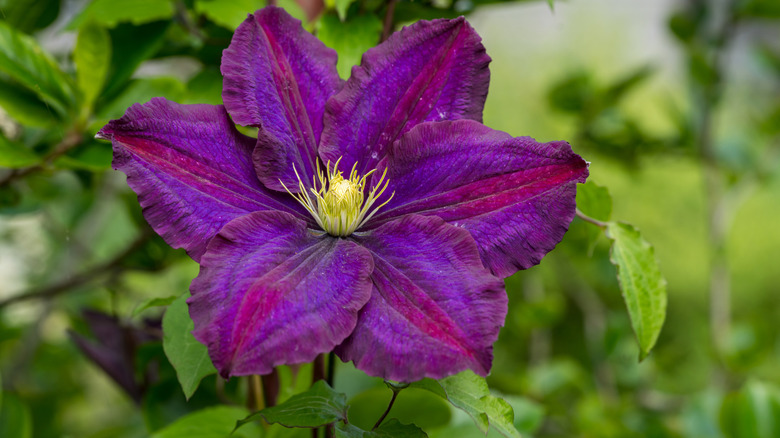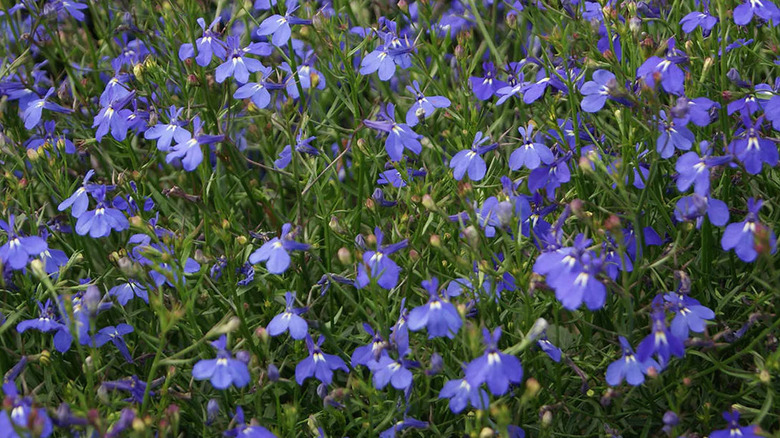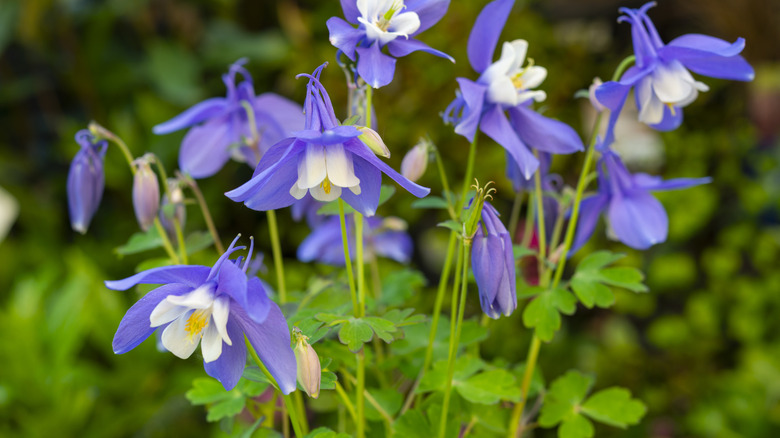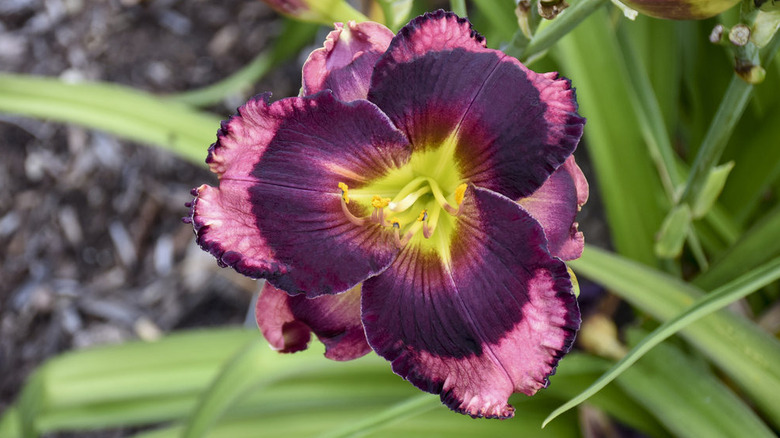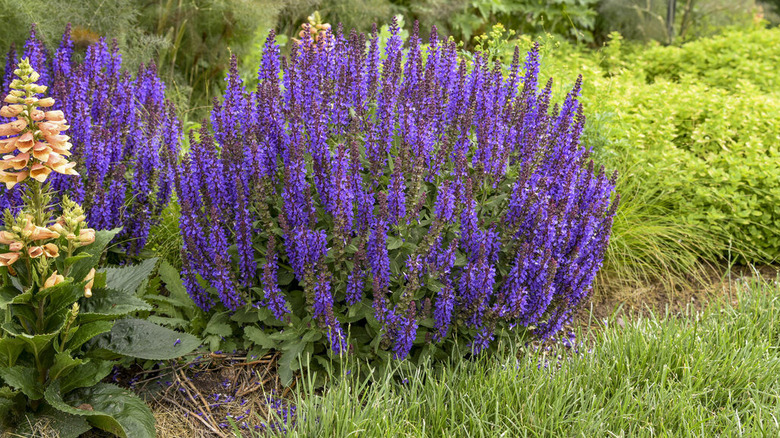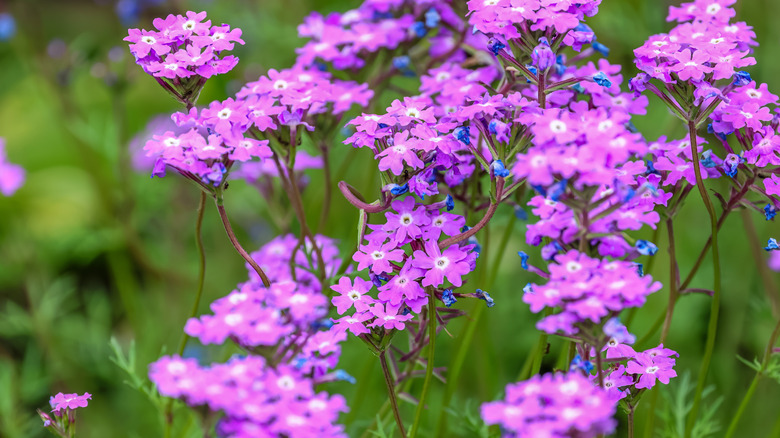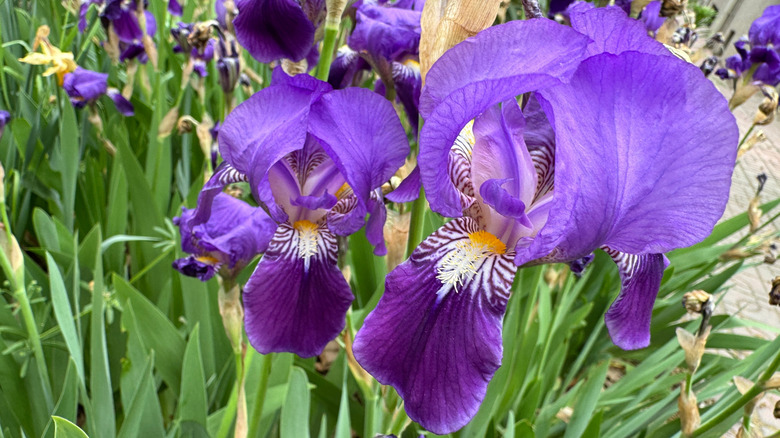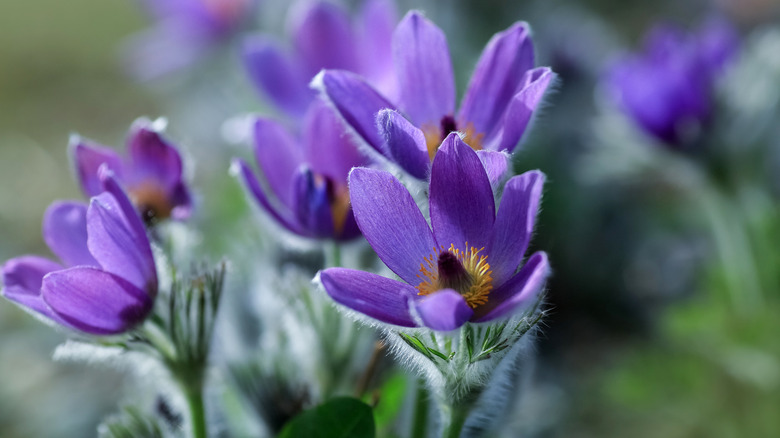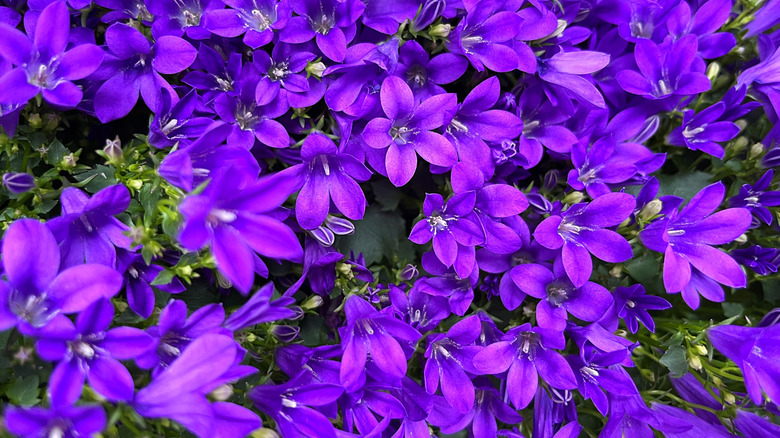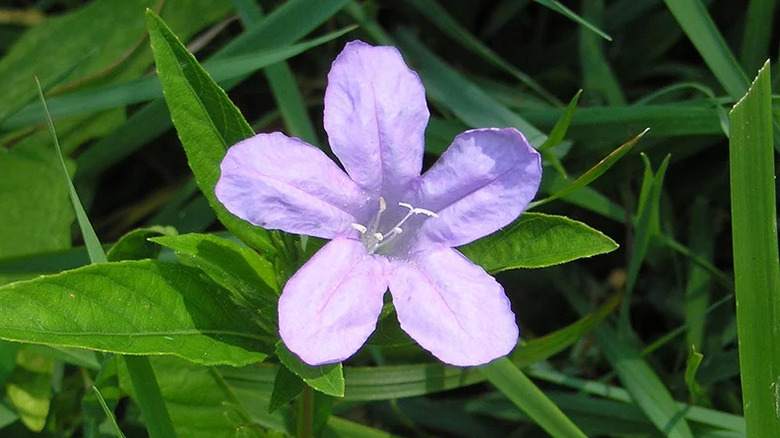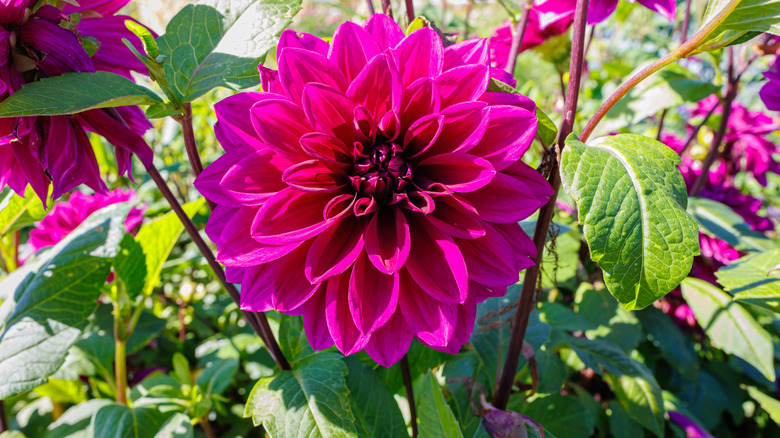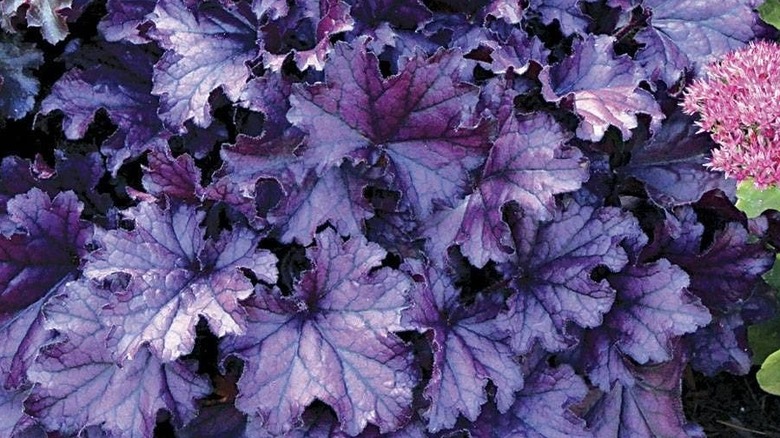15 Purple Perennials To Plant In Fall To Enjoy Year After Year
If you've been working through your fall to-do list for the garden of your dreams, you may be busy removing damaged or diseased foliage, raking up leaves to use as mulch, and composting any spent annuals. One important aspect of fall garden care is sprucing up your space with new plantings! Thanks to the mix of warm soil and cooler temperatures, fall is an excellent time to plant perennials that will bloom in your garden for years. These conditions are excellent for root growth. If you live in colder climates, it's important to plant your perennials at least six weeks before the first frost, in order to give their root systems plenty of time to establish themselves. From there, it's a matter of adding a protective layer of mulch to keep your plants insulated through the winter and making sure to stay on top of regular watering until the ground freezes.
When deciding which perennials you should plant, there are a dozen approaches to take. Each plant choice should be based on your vision for the garden, the amount of time and effort you can dedicate towards the care of your plants, and the climate you live in. If you want to add a particular color to your garden, consider giving purple perennials a shot. Long known for its association with royalty, mystery, and enchantment, purple flowers can dramatically shift the mood of your space. Purple flowers can also create a sense of depth, making your garden appear larger than it is. Since purple plays well with other colors, you can use it as an unlikely and versatile neutral. Look for popular flowers like dahlias, coral bells, and daylilies in purple hues, and mix them with more unusual choices.
Balloon flower
Balloon flower (Platycodon grandiflorus), a compact perennial, features balloon-like buds that transform into flaring, bell-shaped violet-blue flowers. As the season progresses from summer to fall, their serrated foliage will change from blue-green into dark purple or a combination of light purple and yellow. Growing between 12 to 30 inches tall, balloon flowers are deer-resistant, though keep an eye out for slugs and snails. Hardy in zones 3 to 8, these perennials prefer at least six hours of full sun, though they will tolerate partial shade. It does well in loamy, moist soil with excellent drainage.
Speedwell 'Magic Show Purple Illusion'
Speedwell 'Magic Show Purple Illusion' (Veronica) features thick spikes of purple blooms. In general, speedwells are low-maintenance plants that can tolerate a wide variety of soils. Hardy in zones 4 through 8, it forms in a clump, and will grow between 16 to 18 inches tall and wide. Blooms emerge in the early summer and last until mid-summer. With the ability to thrive in full sun and partial shade, this speedwell prefers humus-rich soil that is well-draining. These blooms are perfect for combination containers and as an edging plant.
Allium
Allium (Allium) are generally hardy in zones 4 through 9, though it depends on the variety you're growing. This easy-to-care-for perennial can grow between one and three feet tall. Defined by globe-shaped blooms that are supported by tall, leafless stalks, alliums can range between six inches and four feet tall. Most alliums thrive in full sun, and they can tolerate many soil types. Just make sure you plant them in fertile, well-draining soil. Since they are related to onions and garlic, deer are repelled by their scent. Purple varieties of this plant include 'Gladiator,' 'Millenium,' and 'Purple Sensation.'
Clematis
A striking flowering vine, clematis (Clematis) can be used in vertical gardens, containers, as groundcovers, and more. Since there are 400 species, cultivars, and hybrids, you can find a clematis for your every need. The smallest species of this plant can grow between two to five feet, and other varieties can reach 30 feet tall. They are slow to establish their roots, but once they do, this plant is a vigorous grower. Generally hardy in zones 4 through 11, clematis prefers moist, well-draining soil. Plant this in an area that will receive at least six hours of full sunlight.
Lobelia 'Sapphire'
Though most known for its blue hue, lobelia (Lobelia) contains more than 400 species in a range of colors, sizes, and growing habits, from lilac and violet to upright and trailing. Featuring clusters of three-petaled blooms and a white center, perennial lobelias will reach a height of four feet. Lobelias appreciate humus-rich, moist soil that is well-draining. The hardiness depends on the particular lobelia you have. For example, the hybrid purple cardinal flower (Lobelia x speciosa 'Vedrariensis') is hardy in zones 3 through 8, while 'Laguna Ultraviolet' (Lobelia erinus 'Laguna Ultraviolet') is hardy in zones 9 through 11.
Columbine
Native to North America, Columbine (Aquilegia) can usually be found in meadows and woodlands in the wild. This perennial is defined by its nodding flowers with spurred petals. The petals are usually bicolor, mixing shades of purple and white, amongst other color combinations. Reaching a height of one to three feet, columbines are hardy in zones 3 through 9. Their bloom season lasts from late spring until early summer. During that time, their tubular flowers will attract pollinators like hummingbirds and bees. Columbines thrive in partial shade and prefer humus-rich soil with excellent drainage.
Daylily 'Storm Shelter'
'Storm Shelter' (Hemerocallis 'Storm Shelter') is a type of daylily that blooms in mid-summer and again later in the season. Growing up to 24 inches tall and between 18 and 24 inches wide, this perennial features fragrant, mauve blooms with an eggplant purple center. Each flower will open in the morning before withering away at night. Hardy in zones 3 through 9, 'Storm Shelter' thrives in full sun, but can tolerate partial shade as well. Extremely adaptable, it can grow in most soils, as long as they are moist and well-draining.
Salvia 'Violet profusion'
Salvia 'Violet Profusion' (Salvia nemorosa 'Violet Profusion') is hardy in zones 3 through 8. These perennial salvias need at least six hours of sun, and prefer soil that is fertile. While 'Violet Profusion,' like most salvia, is drought-tolerant, keeping the soil consistently moist will lead to better blooms. If Grown in a rounded, dense habit, violet flowers appear on rosy purple calyxes from late spring until summer. Perfect for mass plantings and in container gardens, 'Violet Profusion' will reach between 16 and 20 inches tall, with a 16 to 20 inch spread.
Verbena
Verbena (Glandularia x hybrida) varieties can be either mounding, trailing, or upright plants. Depending on the type, verbena can grow between six inches to six feet tall, with a width of one to three feet. Since there are over 150 species, hardiness can vary, but many perennial verbenas are hardy in zones 4 through 11. Featuring clusters of star-shaped blooms, verbena usually blooms from late spring until early fall. They prefer between eight to ten hours of sun, and thrive in soil that is moist, well-draining, and slightly acidic. Try hybrids like 'Superbena Sparkling Amethyst' and 'Superbena Cobalt.'
Reticulated Iris
Reticulated iris (Iris reticulata), also known as netted iris or dwarf iris, is a perennial marked by the net-like design on the surface of its bulb. Its petals feature shades of purple or blue joined by a yellow or white central pattern. Reaching four inches tall, this iris is perfect for rock gardens and containers. Their bloom season begins in late winter and lasts until early spring. Once opened, individual flowers will wither after three to seven days. Hardy in zones 5 through 9, reticulated iris thrives in full sun to partial shade with soil that is well-draining.
Pasque Flower
Hardy in zones 4 through 8, pasque flower (Pulsatilla vulgaris) is a low-growing perennial known for its bell-shaped blooms and hairy foliage. Its clump-forming mound can reach between nine and 12 inches tall and wide, with stems that can grow between five and eight inches tall. Pasque flower does best in locations that receive full sun, and prefers soil that is fertile, moist, and well-draining. Rabbits are not a fan of this flower, and you don't have to worry about insects or diseases. An early-bloomer, its flowers usually open in April, and its bloom season will last until May.
Bellflower
Bellflower (Campanula) is a low-growing perennial groundcover that will attract a bevy of pollinators to your garden. Hardy in zones 3 through 9, bellflowers include about 300 species, offering options that fit many needs. Bellflowers can range from 4 to 48 inches tall and wide, and they work well in mass plantings, rock gardens, containers, and as edgings along walkways. Depending on the variety, flowers will bloom from late spring until early fall. It's best to plant bellflowers in an area that will receive full sun, though it doesn't like extreme heat. Plant it in rich, well-draining soil.
Carolina Wild Petunia
Native to the southeastern United States, Carolina wild petunia (Ruellia caroliniensis) is often found on lawns and woodlands. This unbranched perennial usually grows between two to three feet tall. After opening, its purple flower usually withers within a day. Despite this, its overall bloom season lasts longer than most flowers. It will bloom for many weeks, usually from spring until fall. Carolina wild petunias prefer partial shade and moist soil that has excellent drainage. Because of its ability to reseed itself, it can spread quickly, so much so that some classify it as a lawn weed.
Dahlia
Dahlias (Dahlia) come in many shades of purple that range from lilac to deep plum. For those in hardiness zones 8 through 10, you can treat dahlia as a perennial. And if you live in zones 9 and 10, you can plant dahlias in September. In general, dahlias need full sunlight, between six to eight hours a day, to produce their vibrant blooms. They also do best in rich, loamy soil with proper drainage. Check out purple varieties like 'Emperor,' 'Striped Ambition,' and 'Thomas Edison,' which is one of the most popular purple cultivars of this flower.
Coral Bells 'Forever Purple'
Coral Bells 'Forever Purple' (Heuchera 'Forever Purple') is an evergreen perennial known for its glossy, deep purple foliage with ruffled edges. Perfect as a groundcover or edging along paths, beds, and borders, 'Forever Purple' will grow up to 12 inches tall and 22 inches wide. Its striking purple color will last all year, through every season. From late spring until late summer, light violet flowers will appear on burgundy stems. Hardy in zones 4 through 9, 'Forever Purple' can handle full sun and shade, and prefers rich, moist, well-draining soil.
